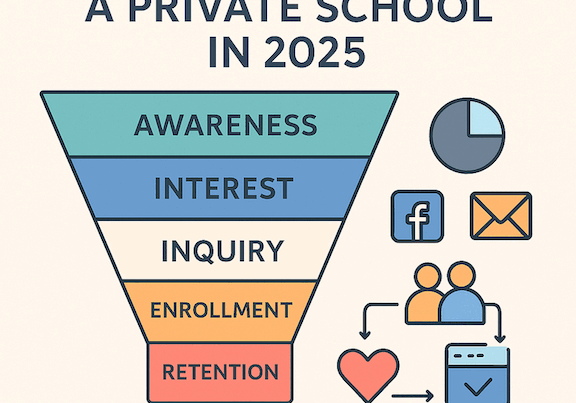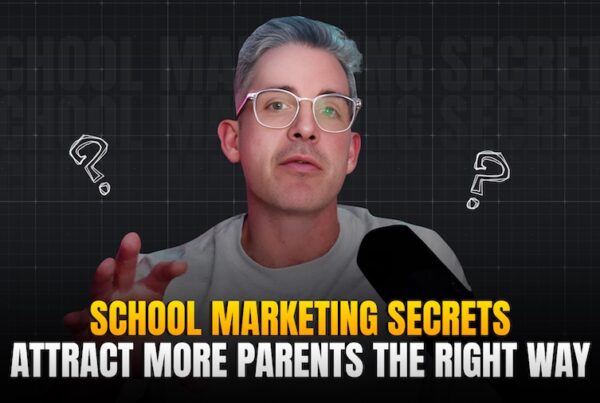
Fortunately, social media can be used to your school’s advantage without breaking the bank, but it has to be done correctly! Let’s talk about social media best practices for schools.
Social Media Best Practices For Schools: 1. Have A Strategy
No matter the business or program that’s being marketed, a strategy is imperative when it comes to social media. Plenty of important factors play a role when it comes to social media marketing, so it’s important to have a clear strategy before developing and working within that outline.
Conversely, the ultimate objective is likely to increase enrollment, build affinity with current stakeholders, or even develop a following within the current student body. If you know the goals and try to set realistic ones, it will be easier to work out a plan from there.
Once you develop a strategy, share it with anybody working to implement it. Have clear objectives, quality standards, content guidelines, and schedules in place, which will set the tone at the beginning and ensure a more appropriate execution.
2. Create A Schedule
A proper social media strategy must include a posting schedule and the resources to follow through with it. Social media users prefer consistent, quality content, and this will need to be displayed on your profile. You will need to determine the target audience, whether it is students, parents, or your local community.
Whomever you are trying to reach, try to post at times when they are most likely to be active on social media. If you are trying to reach students, a post that is launched during the 4th period won’t live up to its full potential. Parents will also be busy in the middle of the day at work.
Try to post at peak social media times for whatever target demographic you are trying to reach, which will maximize the outreach of all the content you post.
An alternative is to develop a schedule for content creation ahead of time. If you know that your plan is to have 10 posts between Monday and Friday every week, you could have a deadline for 8 of those posts to be prepared by Monday in advance for the week, which will save you several headaches as time passes.
Incidentally, following these steps will provide you with leeway for improvised content throughout the week, and be able to save some left-overs content for the next week, in the event that you need them. An example of improvised content would be a “Student Spotlight” if a student had an outstanding achievement that should be celebrated that week, or an incredible art project worth sharing with the world.
3. Utilize Hashtags Wisely
Ordinarily, if the target audience is a younger demographic, they can spot a poorly-used hashtag from a mile away, making this one of the critical social media guidelines.
Nevertheless, hashtags are incredibly effective when added correctly. Assuming you are posting at the right times, you can broaden your outreach significantly just by adding this symbol to the forefront of a word or two.
Avoid using them too frequently but research what is trending and see if the plan can still function with any of your improvised or planned content. Users will click on the trending hashtags throughout the day and may just stumble upon your post, which is a free way to receive attention.
Implement hashtags related to education or the school day. Some examples would be:
- #CasualFriday
- #K12
- #eLearning
- #ZoomClass
- #Learning
Alternatively, try searching for local hashtags to attract local attention. Communities often have trends being utilized on social media that you can incorporate into your content strategy.
4. Optimize Your Profile
While creating the account (on any platform), be mindful to select a business account. If you haven’t already done that, you should switch account types.
From there, add a few extra steps to ensure that the profile is optimized for users who find your page. Begin the process with the photo to ensure that it is legible without clicking on it or zooming in.
If you’ve ever noticed how Instagram profile pictures appear on a mobile phone, you’ll know it’s often difficult to read what they say. A clear picture of the school logo is an ideal choice or even a high-resolution photo of the school building. Learn more about Instagram for Schools here.
When adding a title, ensure that it is clear and concise: “Generic Title Vocational School”. Omitting the location or any other information will be acceptable. That is the purpose of a bio.
Ideally, in your bio, you should add a brief description of your school, its location, and a link to its professional website, which will appear to users who click on the profile. You can add contact information or other links below but you should start with two quick lines with that necessary information.
5. Create Landing Pages
Assuming you are trying to market the school, treat its social media account as if it were an ad campaign to an extent. Don’t post content that appears as if it were an advertisement but use the opportunity to bring traffic to your website.
Landing pages where you are directing followers need to be nearly perfect. They should load quickly, have user-friendly navigation tools, and display all of the necessary information. Remember, the average web user will leave a website after only 3 seconds.
6. Share Content
One of the most significant benefits of marketing a school on social media is that you have an ample amount of content to share. You will have a network of teachers, students, alumni, parents, and industry leaders to choose from.
Follow some of your students and other relevant people on social media platforms and share some of their content if it will help promote the school. For example, if a student posts about their pride in a breakthrough they had in music class, lift their spirits up and promote this positive experience in your school by sharing it.
Whether or not you’re running behind on content, this is a great way to provide followers with more quality content throughout each week.
7. Tell Parents
Tell students and parents about your social media presence and let them know that event updates and other important information will be posted there regularly. The majority of parents will seek out the information and will even help spread it to other parents in the community.
Moreover, you should have flyers at the school, tell students to pass along the information, and send out your social media accounts in your email campaigns and other online activities.
8. Analyze And Track
Track the number of followers, likes, shares, comments, and other metrics over time to monitor how they progress. Perhaps you notice that certain types of posts are not receiving as much engagement, if some posts are receiving negative responses or anything else that puzzles you, it will help you determine how to adjust the strategy moving forward.
Consequently, use a wide variety of content from the beginning and seeing what works. Video marketing tends to be highly effective, especially for schools, but you should figure out what works for your audience.
Remember that social media is a marathon, not a sprint, as it is an ongoing process that requires time and patience for success, so having a way to track your goals is an important part of your strategy.
9. Ask Teachers For Help
Some teachers will have social media accounts to give out homework reminders and other important information to their students. In this case, ask them to promote or share the school’s content periodically.
Having all hands on deck within the school will only help with the strategy, and it’s another way to promote the school’s account.
10. Interact
Remember that it is called social media. We mentioned the importance of sharing other people’s content but that’s not all. Commenting on other posts within the school’s community, following other businesses and schools, and responding to questions from followers is crucial.
People prefer to believe there is a human presence behind any brand, especially in an industry as social as education. Try to prevent people from getting the sense that there’s a robot behind the scenes that is timing the content.
Be Consistent
Now that you know the social media best practices for schools, it’s time to put them into place and be consistent. Remember to be consistent with timing, expectations, and analysis, and you will notice results. Stay up to date with our latest marketing news and contact us with any questions about your social media campaign!



